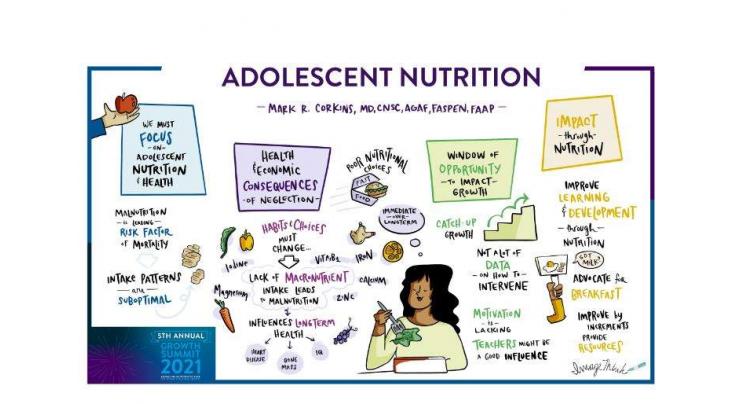
Addressing The Menace Of Adolescence Malnutrition Is The Need Of The Hour
Umer Jamshaid Published June 11, 2021 | 11:22 AM

According to a report ‘Healthy profession, healthy patients: The state of clinical nutrition in Pakistan’ published by The Economist Intelligence Unit, over 37 per cent of the households in the country suffer from food insecurities, leading to malnutrition among all age groups, but particularly affecting the infants and adolescents at large
According to a report ‘Healthy profession, healthy patients: The state of clinical nutrition in Pakistan’ published by The Economist Intelligence Unit, over 37 per cent of the households in the country suffer from food insecurities, leading to malnutrition among all age groups, but particularly affecting the infants and adolescents at large.
The eye-opening number is not only indicative of the poor socio-economic conditions of the country, but also puts Pakistan in a conundrum, which has a median age of 22. According to the data shared by Pakistan Bureau of Statistics (PBS) , more than 50pc of the population accounts for the youth.
To ensure that the youth of the country reaches its full potential, it is imperative to address the issues related to malnutrition.
In its efforts to shed light on how adolescence malnutrition is an important topic but remains rather ignored, Abbott hosted a session named ‘Adolescent Nutrition: A Time for Action’ at its 5th Annual Growth Summit 2021 on May 27, 2021.
Speaking on why the world should focus on adolescent health and nutrition and the economic and health consequences of neglecting adolescent malnutrition, Dr. Mark Corkins, Division Chief of Pediatric Gastroenterology and Professor of Pediatrics at the University of Tennessee Health Science Center and Le Bonheur Children’s in Memphis, TN, stated: “We currently have the largest generation in human history in the ages 10 to 24; 1.
8 billion individuals. And 90pc of these folks belong to low or middle income countries.
“In 2015, nearly a million adolescents died. Malnutrition is the leading risk factor contributing to the predominant causes of death. So, malnutrition is not the leading cause. It’s the leading risk factor,” Dr. Corkins explained.
According to Dr. Corkins, questionable diet choices by adolescents are one of the key reasons why most of them grow up to be malnourished and how it can also wreak havocs on their emotional health.
Many adolescents have lost their lives over the years due to malnutrition related causes in the developing countries. In the context of countries such as Pakistan, where the young reign supreme, it is essential to formulate and implement strategies to eradicate or minimize the damage inflicted by adolescence malnutrition.
Developing countries such as Pakistan cannot risk losing a better half of their young and vulnerable population if they are to prosper economically. A stunted or malnourished adolescent population does not bode well for a country whose youth accounts for over 50pc of the total population.
The relevant authorities in Pakistan can follow Abbott’s 5th Annual Growth Summit in order to formulate strategies that might yield fruitful results by curtailing or minimizing the problem of adolescence malnutrition in the country.
Recent Stories

HEC reviews curricula for environmental sciences degree programme

ICC Asia looking forward to an action-packed Asia Cricket Week

Yuvraj Singh named ICC Men’s T20 World Cup 2024 Ambassador

Greece hands Olympic flame to 2024 Paris Games hosts

Two Kyiv hospitals evacuating over feared Russian strikes

World must act on neurotech revolution, say experts

Charles & Catherine's cancer diagnoses

Champions Alcaraz and Sabalenka through in Madrid Open

King Charles to resume some public duties during cancer treatment: palace

US defense chief announces $6 bn in security aid for Ukraine

Heavy rains cause damage to Spezand-Taftan railway track

Woman stabbed in Israel, attacker killed: police
More Stories From Blog
-

The Economic Challenges for the New Government
1 month ago -

How a Second Passport Can Enhance Your Travel and Business Opportunities
1 month ago -

Reading Minds
2 months ago -

Human Rights Situation in Pakistan: A Comprehensive Analysis
5 months ago -

Climate change poses imminent threat to global biodiversity
5 months ago -

Unprecedented floods in Pakistan
8 months ago
-

Sonia Ahmed's vision elevates Miss Pakistan to Global prominence
8 months ago -
Armed forces, intelligence agencies protecting country’s fabric from proxy wars: experts
11 months ago -

Lawmakers denounce strongly Indian nefarious move for Yasin Malik’s sentence
11 months ago -
Written in blood: a poignant story of our invincible warriors, martyrs
11 months ago -

Proportial voting in Pakistan
1 year ago -
Three Jewels fading from Lahore’s architectural crown
1 year ago








